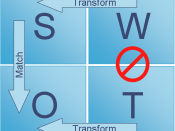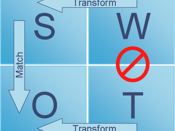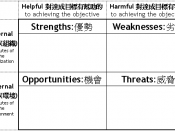Strategy, change and innovation
We are told by writers on strategy that we should keep the environment under constant review. Form the point of view of strategic management, what is the practical use of knowing what is going on in the environment? Can environmental scanning tools be distinguished in terms of ( a ) the information they provide and
( b ) the use that can be made of that information, and which tools would you use in what circumstances?
Introduction
Strategy - There is no absolute answer about what is strategy, as it will change with its external and internal environment. According to the Henry Mintzberg (1994, The Rise and Fall of Strategic Planning), he pointed out that people use "strategy" in several different ways, the most common being these four:
Strategy is a plan, a "how," a means of getting from here to there.
Strategy is a pattern in actions over time; for example, a company that regularly markets very expensive products is using a "high end" strategy.
Strategy is position; that is, it reflects decisions to offer particular products or services in particular markets.
Strategy is perspective, that is, vision and direction.
Mintzberg argues that strategy emerges over time as intentions collide with and accommodate a changing reality. Thus, one might start with a perspective and conclude that it calls for a certain position, which is to be achieved by way of a carefully crafted plan, with the eventual outcome and strategy reflected in a pattern evident in decisions and actions over time. This pattern in decisions and actions defines what Mintzberg called "realized" or emergent strategy. May be you will ask, what kind of reasons will make strategy not work. There are a few examples:
Condition change
Customers didn't respond the way we had hoped.
The organisation resisted change
The skilled that we need is not develop in time
In this case, a constant review of the environment may able to reduce any dissatisfaction of the failure of the strategy.
In describing external analysis, Fahey and Narayanan (1986) suggest that organizations scan the environment to identify changing trends and patterns, monitor specific trends and patterns, forecast the future direction of these changes and patterns, and assess their organizational impact. Merged with internal analysis of the organization's vision, mission, strengths, and weaknesses, external analysis assists decisionmakers in formulating strategic directions and strategic plans.
The goal of environmental scanning is to alert decisionmakers to potentially significant external changes before they crystallize so that decisionmakers have sufficient lead time to react to the change. Consequently, the scope of environmental scanning is broad.
Environment Domains is a very board area, External environment refers to those people, resources, leadership and communication structures existing outside the organizational structure which may involve the following sector
Industry sector
Raw material sector
Financial sector
Market sector
Technology sector
Government sector
International sector
Internal and External Analysis
Internal analysis of the organisation is a practice that to help us to identifying the Strengths and weakness of the company, which point out some key factors that able the organisation to get a better advantage of the market. And the most common tools are
Core Competencies
Stakeholder Analysis
Value Chain
Financial Analysis
Core Competencies
Core competencies are those capabilities that are critical to a business achieving competitive advantage. The starting point for analyzing core competencies is recognizing that competition between businesses is as much a race for competence mastery as it is for market position and market power. Senior management cannot focus on all activities of a business and the competencies required undertaking them. So the goal is for management to focus attention on competencies that really affect competitive advantage1
Distinctive competencies
Firm-specific strengths that allow a company to gain competitive advantage by differentiating its products and/ or achieving lower costs than its rivals by arise its resources and capabilities
Resources represent inputs into a firm's production process - such as capital equipment, skills of employees, brand names, finances and talented managers. A valuable resource that creates strong demand for a firm's products may lead to distinctive competency3
Capabilities represent- the firm's capacity or ability to integrate individual firm resources to achieve a desired objective. Capabilities develop over time as a result of complex interactions that take advantage of the interrelationships between a firm's tangible and intangible resources that are based on the development, transmission and exchange or sharing of information and knowledge as carried out by the firm's employees.
Superior Efficiency is the is the main driver to success, Efficiency will tend to lower the manufacturing cost/ running cost, As a result, a higher profit will be make by the organisation. In this time, we may able to increase the spending in the R & D, to develop a higher quality of the product, as the quality increase we are able to sell our product in a higher price and generate more profit. As a result we can lower the production cost, higher the profit of the company, and keep monitoring what our customer need and satisfy our customer. These will create a highly competitive advantage for the organisation.
Analysis the external environment will assist you in identifying possible pastoral opportunities and threats which you may be facing. Opportunities are potential areas of new or expanded pastoral gains. They are areas you may not have previously been aware of, such as areas of changing political or economic climate, or change in leadership at the parish or diocesan level, or in areas of technological changes. You will know them when you see them. These are an area which helps facilitate or expand the apostolate of your organization/movement.4
On the other hand, Threats are those you may have probably knew about and could be easier identified than opportunities. Threats are those that hinder your organization or movement in accomplishing its task.
There are number of tool are available to help us to identifying these opportunity and threads, the most common one are the Port's Five Forces and SWOT analysis, to help us identify our market position.
SWOT analysis (Strength, Weakness, Opportunity and Threads)
Its purpose is to identify company strengths and weaknesses so that strengths can be maintained or increased and weaknesses corrected. A further purpose is to identify opportunities and threats resulting from external factors - especially those that have an impact on the company's strengths and weaknesses. Company strengths and weaknesses need to be identified in all aspects of the business5
o relative to the rest of the market (i.e. compared to competitors)
o relative to previous performance or expected performance
o relative to customer demand (for example all companies in an industry may fail to satisfy a particular customer need. This is a weakness - and the first company to match this customer need will have a strength relative to the other companies in the industry.)
It is also important to realize that opportunities arise out of weaknesses. Correcting a weakness presents a marketing opportunity. Similarly, failing to maintain a strength is a threat to the company.
A preliminary approach for carrying out a SWOT analysis is to list perceived company strengths, weaknesses, opportunities and threats under each of these headings. Ensure that no weaknesses cancel out company strengths and potential threats to the company strengths or opportunities that could arise out of correcting weaknesses.
Porter's five forces analysis - will helps the marketer to contrast a competitive environment. It has similarities with other tools for environmental audit, such as PEST analysis, but tends to focus on the single, stand alone, business or SBU (Strategic Business Unit) rather than a single product or range of products.6
Risk of Entry by Potential Competitors2
Barriers to entry
Absolute cost advantage
- Superior production operations and processes
- Control of particular inputs required for production
- Access to cheaper funds because existing companies represent lower risks than new entrants
Economies of scale
- Cost reductions from mass producing a standardized output
- Discounts on bulk purchases of inputs
- Advantages of spreading fixed costs over a large production volume
- Cost savings from marketing and advertising for a large volume of output
Customer switching costs
The Bargaining Power of Buyers
Buyers are most powerful when
- The industry that is supplying a particular product or service is composed of many small companies and the buyers are large and few in number
- Buyers purchase in large quantities
- The supply industry depends on the buyers for a large percentage of its total orders
- Switching costs are low
- It is economically feasible for buyers to play one supplier against another
- Buyers can threaten to produce the product themselves
The Bargaining Power of Suppliers
Suppliers are most powerful when
- There are few substitute products
- The industry is not an important customer to the supplier
- Switching costs are high for companies switching to a different supplier
- Suppliers can threaten to compete directly with buyers by entering their industry
- Buyers cannot threaten to enter the suppliers' industry
Substitute Products
Many substitute products
- Are a threat and limit the price that companies in one industry can charge for their product, and thus industry profitability
Few or weak close substitutes
- Gives the industry the opportunity to raise prices and earn additional profits
Rivalry among Established Companies
Industry competitive structure
- Fragmented vs. consolidated (oligopoly or monopoly)
Industry demand
Exit barriers
- Investments in assets of little or no alternative value or that cannot be sold
- High fixed costs of exit
- Emotional attachments to an industry
- Economic dependence
Strategy Formulation
Once a clear picture of the firm and its environment is in hand, specific strategic alternatives can be developed. While different firms have different alternatives depending on their situation, there also exist generic strategies that can be applied across a wide range of firms.7
Implementation
The strategy likely will be expressed in high-level conceptual terms and priorities. For effective implementation, it needs to be translated into more detailed policies that can be understood at the functional level of the organization. The expression of the strategy in terms of functional policies also serves to highlight any practical issues that might not have been visible at a higher level. The strategy should be translated into specific policies for functional areas such as:7
Marketing
Research and development
Procurement
Production
Human resources
Information systems
In addition to developing functional policies, the implementation phase involves identifying the required resources and putting into place the necessary organizational changes.
Case Study: Ford Motor Company (Source from: Power Point Presentation of Stevens Institute of Technology) 8
Ford Motor Company is the Second's large industrial corporation of cars and trucks with products sold in more than 200 countries, and had already produced 260 millions of vehicles. With inherent large-scale growth issue, and pressure, Ford trying to increase their competitive advantage by re-organise their infrastructure of their organisation.
What they have done is use a list of scanning tools to analyse their current position of the company.
A key step in the process was the use a Ansoff Matrix analysis to identify the current Market position and it will given you a general ideas that what you can do without detail thinking. Then with the Porter's Five Force, After that will use of a SWOT analysis which drew on information and data collected during the market audit, the focus of attention was both on internal and external factors and these provided a valuable input into formulation of marketing objectives and strategies. The aim of such an analysis, in essence was to identify ways in which to exploit the organisation's strengths or capabilities and maximise the opportunities offered by the market, while addressing corporate weaknesses and minimizing external threats.
By doing the Ansoff matrix, they have identified four different categories that they can do with the future, either
Keep using the Existing Product for the Existing Market with added Service to customer and Better Customer Satisfaction)
Develop a New Product for the Existing Market. E.g. Jet Engine etc
Use the Exiting Product for a New Market - Global Expansion, Lower price
New product for New market, Selling automobile parts for all centres
Porter's Five Forces Analysis
It list out a number of force which may decrease the competence of the organisation.
There are also some more which also will affect the organization, e.g. Political & Legal Environment, regulations change, and any change of marketing Environment
SWOT analysis
It not only listed out the problem of the company, but also a number of ways which able the company to overcome it threats and weaknesses to become an opportunity.
After the analysis the company will withheld a list of the weakness, alternative, and recommendation. At that time, the company itself can generate this information in a formation of strategy objective. By a further investigation of each scenario they select the strategy they can use and implement it in the organisation.
So, what did Ford motor does, is identified it's alternatives
Do Nothing
+ With the advent of emerging technologies Ford may start loosing the competition
- No immediate cost involved
Join hands with the suppliers
+ Improved IT infrastructure
+ Improves SA Maturity
+ Improves relationships and integration
- May become limited to the supplier
Target global markets
+ Increased market
- New market may have more challenges
Co-brand products that appeal to existing population (e.g., Loans, cars, car renting)
+ Respected and valuable brand name
- The integration of products and services may result in larger customer base.
Integrate of Purchasing and Production department
+ Lower costs due to storage, obsolescence
+ More flexibility for the production department
- Strong resistance for integration
Market new products to existing customers
+ Easy target, experience with existing customers
- The profitability may not be too high
And this is what did they chosen to do about their strategy
Partner with the suppliers
+ Better integration
+ Improves SA Maturity
+ Economies of scale on the long run
Integration of Purchasing and Production department
+ Lower costs due to storage, obsolescence
+ More flexibility for the both the departments
+ Better integration will increase the manageability
Co-brand products that appeal to existing population (e.g., Loans, cars, car renting)
+ Brand is strong, respected and valuable
+ The integration of products and services may result in larger customer base
In August2002, standardization and simplification has saved FORD amounts of &150M per year out of $3B budgets. (See appendix for attachment of PowerPoint presentation)
Conclusion
In modern world of rapid, often unexpected change, increased uncertainty, the global nature of business, and rapid technological advances, Strategic planning can make an important contribution to the organization's growth and survival in uncertain environments. In essence, the process of making strategic decisions usually involves not only the analysis of the organization's strengths and weaknesses but also the identification of opportunities and threats in the external environment. This unit highlights the importance of an effective environmental scanning system to provide crucial inputs to the strategic decision making process.
As there are too many technique available. In practice the choice of technique used will tend to be conditioned by a variety factors, including the type of information you required, the extent and the accuracy of data available, the time factor, resource constraints and the perceived importance of the forecast to the process of organizational decision making.
Word Count:
2748
Reference:
1: www.tutor2u.net/business/strategy/ core_competencies.htm
2: Strategic Management By Charles W. L. Hill
3: www.stfx.ca/people/twhynes/Bsad471.20/Powerpoints/ Chapter%205%20Business%20Level%20Strategy.PPT
4: http://www.geocities.com/antioch_manila/antioch_consultancy/swot.html
5: www.marketing-intelligence.co.uk/ help/Q&A/question24.htm
6: www.marketingteacher.com/Lessons/lesson_fivefoces.htm
7: www.netmba.com/strategy/process/
8: Power Point Presentation From Stevens Institute of Technology- http://attila.stevens-tech.edu/~riyer/document/FMC-RAM.ppt


